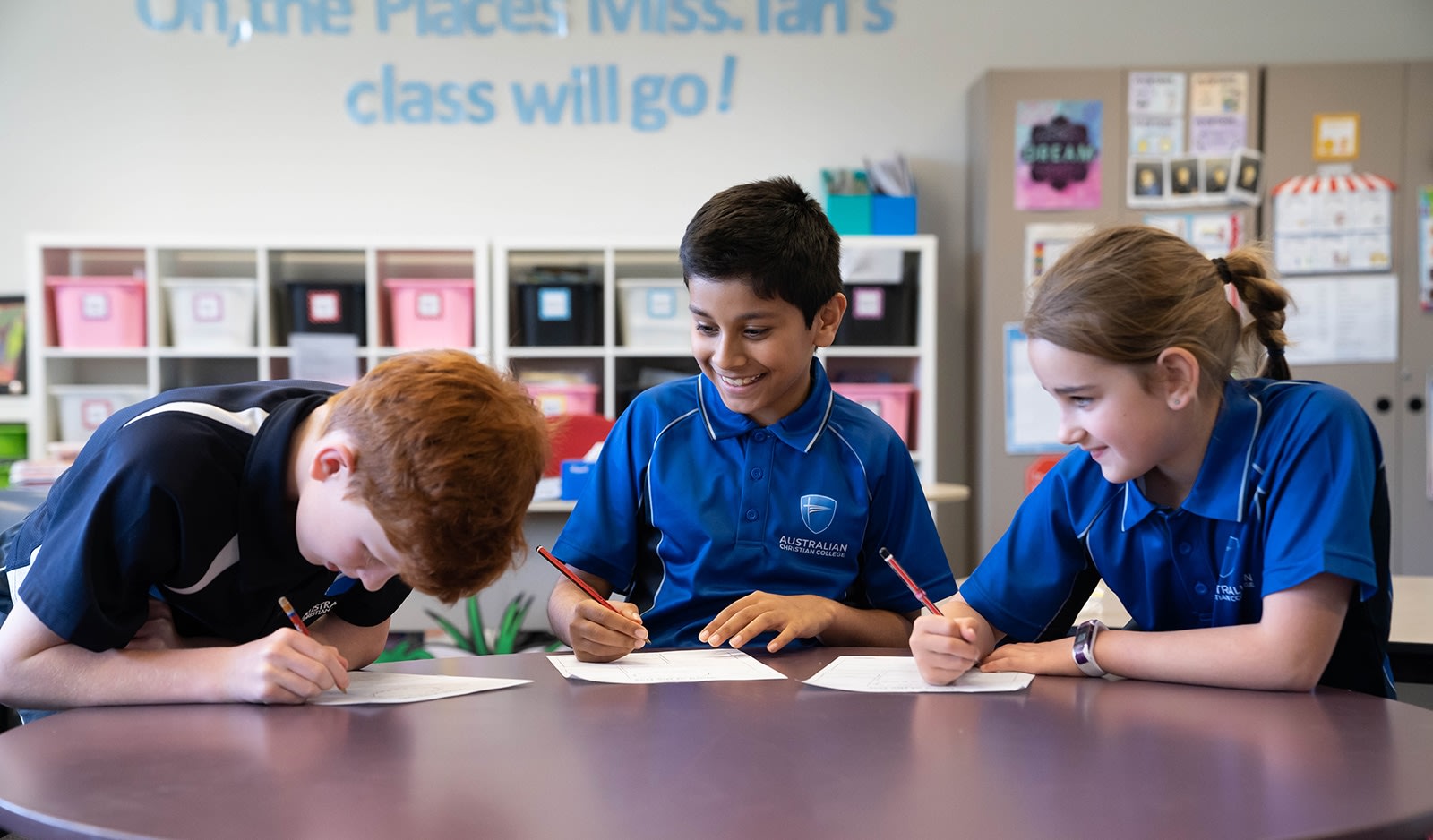Literacy and the Australian Curriculum

Table of Contents
- Defining and understanding literacy
- The essential role of literacy in modern culture
- What are the key elements of literacy?
- What are the different literacy teaching techniques?
- Quality teaching framework and its role in student learning
- Literacy continuum and student support
- How can parents help their child’s literacy?
There’s a lot more to a school than the “three Rs”, but becoming proficient in English communication remains a vital part of a good education. The Australian curriculum is designed to make sure students develop a level of literacy that will help them succeed in life and work.
Defining and understanding literacy
As UNESCO notes, “literacy” would seem to be a word that everyone understands. However, it’s a complex and dynamic concept that can be interpreted in numerous ways. Many factors influence what people think it means to be literate or illiterate, such as the national context, academic research and personal experiences.
So, just what is it? In the Australian Curriculum, students are said to become literate “as they develop the knowledge, skills and dispositions to interpret and use language confidently for learning and communicating in and out of school and for participating effectively in society.”
The Australian Curriculum, Assessment and Reporting Authority (ACARA) note that literacy involves students interacting with texts in different ways; for example, reading, viewing and listening. It also involves creating texts through speaking or writing. Texts can take different formats, such as print, digital and visual.
Furthermore, literacy includes the ability to use and modify language for various purposes in different contexts. For example, creating a slide presentation for a science project, a composition for English, or reading questions on a Mathematics test.
Becoming literate is about more than acquiring knowledge and skills; it is concerned with the ability to confidently and effectively apply them in order to interpret and communicate meaning regardless of the context. It helps students to be critical thinkers, better managers of their own learning, and more open to ideas and opinions of others.
The essential role of literacy in modern culture
While the rise of digital technology might have you wondering whether skills in comprehension and composition are dying, the truth is that literacy is as essential for success in modern society as it was in the past.
As the United Nations Secretary-General Ban Ki-moon noted in 2016, literacy “... is a foundation for human rights, gender equality, and sustainable societies. It is essential to all our efforts to end extreme poverty and promote well-being for all people.”
The ability to read and write is crucial for success at school – not just in English, but every area of the Australian Curriculum. Effective comprehension and communication are just as important for Science and Technology as for language-based subjects.
Moreover, literacy is necessary for almost every life situation, including work, leisure, and relationships. As pointed out in the National Inquiry into the Teaching of Literacy Report, “literacy competence is foundational, not only for school-based learning but also for children’s behavioural and psychosocial wellbeing, further education and training, occupational success, as well as for productive and fulfilling participation in social and economic activity.”
The report, which was published more than a decade ago, adds that the rapidly changing nature of technology and communication systems require competence in increasingly complex and varied types of literacy. If this was true, then, it is even more so now.
In a Christian context, literacy is essential for understanding the Bible, participating actively in church life, and fulfilling your God-ordained purposes for life and service.
What are the key elements of literacy?
Literacy can be divided into two main categories on a ‘learning continuum’ that becomes increasingly complex and specialised as students progress through their schooling. They are:
1. Comprehending texts through listening, reading and viewing.
This involves students developing the skills needed to access and interpret various types of texts, including spoken, written and visual ones. It includes strategies like listening, understanding and evaluating information and points of view.
2. Composing texts through speaking, writing and creating.
This involves the development of expressive language as students compose texts for various purposes. It includes using strategies to communicate information and ideas, such as in-class discussions and presentations.
Literacy conventions are further divided into four elements:
Text knowledge
This involves students understanding how various texts are structured to fulfil their purposes, which may include presenting information, explaining processes, investigating, and supporting points of view.
Grammar knowledge
This involves students understanding how grammar helps to build meaning in texts. It includes learning how sentence structures and different types of words carry information and represent ideas.
Word knowledge
This is about developing increasingly specialised vocabulary and spelling.
Visual knowledge
This involves students understanding how visual information – such as images, graphs and maps – contributes to text meaning.
What are the different literacy teaching techniques?
Just as literacy is a complex topic, so is the thinking around the best way to teach it. Methods for teaching literacy are often divided into two main approaches.
1. The “phonics” approach
This is based on the understanding that there is a predictable relationship between ‘phonemes’ (the sounds of spoken language) and ‘graphemes’ (the written letters that represent those sounds). Students learn to recognise these relationships and use them to read familiar words and figure out how to read (or ‘decode’) unfamiliar ones.
Students learn to blend sounds to form words. For example, they learn that ‘c’, the first sound in cat, blends with ‘a’ and ‘t’. They also learn how to chunk letter sounds together (e.g. ‘a’ and ‘t’ to make ‘at’).
One problem with this approach is that English words frequently don’t have a simple symbol-to-sound relationship. The letter ‘a’, for example, represents different sounds in ‘cat’, ‘fast’, ‘ball’ and ‘baby’. This means students must also learn how to decode sounds based on other factors, such as the surrounding letters. Another challenge is the many homonyms (words that sound the same but are spelled differently) in English, such as ‘rain’, ‘reign’ and ‘rein’.
Some words may, therefore, need to be memorised using visual cues.
2. The "whole language" approach
This method emphasises literature and text comprehension. Students are taught to look at the context and use critical thinking to deduce the meaning of words they don’t recognise.
This approach involves providing a literacy-rich environment for students with an emphasis on text meaning rather than letter sounds.
This is classed as a ‘top-down’ approach where students build meaning from texts based on their prior knowledge combined with comprehension of what they’re reading.
Potential drawbacks include a lack of emphasis on word analysis, which may lead to young readers simply guessing or skipping over words they find difficult.
Naturally, there is some overlap between these methods. However, the National Inquiry into the Teaching of Literacy Report states they “found strong evidence that a whole-language approach to the teaching of reading on its own is not in the best interests of children, particularly those experiencing reading difficulties. Moreover, where there is unsystematic or no phonics instruction, children’s literacy progress is significantly impeded, inhibiting their initial and subsequent growth in reading accuracy, fluency, writing, spelling and comprehension.”
They add that “systematic phonics instruction is critical if children are to be taught to read well.” Our experience in teaching young children literacy at ACC supports this view. By adopting a Synthetic Phonics approach to teaching reading and spelling, we give students the best for success.
Quality teaching framework and its role in student learning
Regardless of the literacy teaching technique used, quality teaching is crucial to student improvement. The National Inquiry notes that teachers need to use techniques that are best suited to the needs of their students.
They describe it as “a moment of awe to observe an effective teacher, with a full range of skills to teach reading, working with a whole class and having each child productively develop their literacy skills.
“Such teaching is highly skilled and professional,” they explain. “Teachers require a range of teaching strategies upon which they can draw, that meet the developmental and learning needs of individual children.”
They note that a large body of research indicates that high-quality teaching has significant benefits to students’ achievement, irrespective of their background. Furthermore, they point out that well-trained and equipped teachers are crucial if students are to achieve their full potential. All School Principals know this to be true.
It’s important to add that quality teaching is about more than using evidence-based practices. In an article for the Australian Association for Research in Education, Deb Hayes – a Professor of Equity and Education from the University of Sydney – notes that the work of teachers is complex and dependent upon several factors including the local context, their own experience and their relationships with students and their families.
She describes several practices that can lead to “much higher levels of engagement and success by students”. These include:
- recognising knowledge and experiences that students already have and connecting it to school-based learning
- connecting classroom practice to families and communities
- designing open-ended learning tasks that require complex thinking and language
- providing texts that encourage students to think about significant personal and social issues, such as loneliness, hope and relationships.
Literacy continuum and student support
Clearly, developing literacy is a process. To help ensure it is taught consistently and the needs of all students are addressed, ACARA (in collaboration with the NSW Department of Education) have developed a series of so-called ‘Learning Progressions’ for schools.
Formerly called the ‘literacy continuum’, they describe common literacy learning pathways for students from Kindergarten to Year 10. They help teachers to plan their teaching, assess a student's current literacy and monitor their progress over time. Additionally, the progressions establish a metalanguage which provides a framework for staff and students to communicate about literacy development at a whole-school level.
Naturally, some students will understand literacy conventions more easily than others. For various reasons, some students may experience difficulties with developing literacy.
For these students, an individual approach is needed. Evidence shows that the most effective way to support students with learning difficulties involves individualised planning along with a well-structured and explicit teaching approach. A collaborative approach with support from parents will further support these students’ learning.
It might also include consulting other professionals, such as an educational psychologist, or speech-language pathologist.
How can parents help their child’s literacy?
Parents are crucial partners in their child’s literacy development. In fact, research into the so-called ‘parent engagement effect’ by Australian educational researcher Professor John Hattie, showed that consistent parental engagement could add the equivalent of two to three years’ schooling for a child, massively boosting their overall achievement.
Parental engagement includes setting goals together, encouraging good study habits, showing interest in learning and enjoying reading.
Practically, parents can help by:
- having high expectations for the learning and achievement of your children (this had the biggest statistical effect in Hattie’s research)
- reading to your child regularly
- listening to your child read
- supervising homework
- communicating with teachers and the school; and
- providing easy access to literacy resources
- and creating a space in the home that invites your child to practise applying the skills and knowledge that are being taught at school.
We communicate meaning in many different ways; thus, engaging in meaningful, playful conversations with your child provides a safe place for them to see and practise the conventions of speaking, listening, grammar and vocabulary.
If you are worried about your child’s literacy development, the best place to start is with their teacher. They can talk about their observations in the classroom and whether they have any concerns about your child’s progress.
